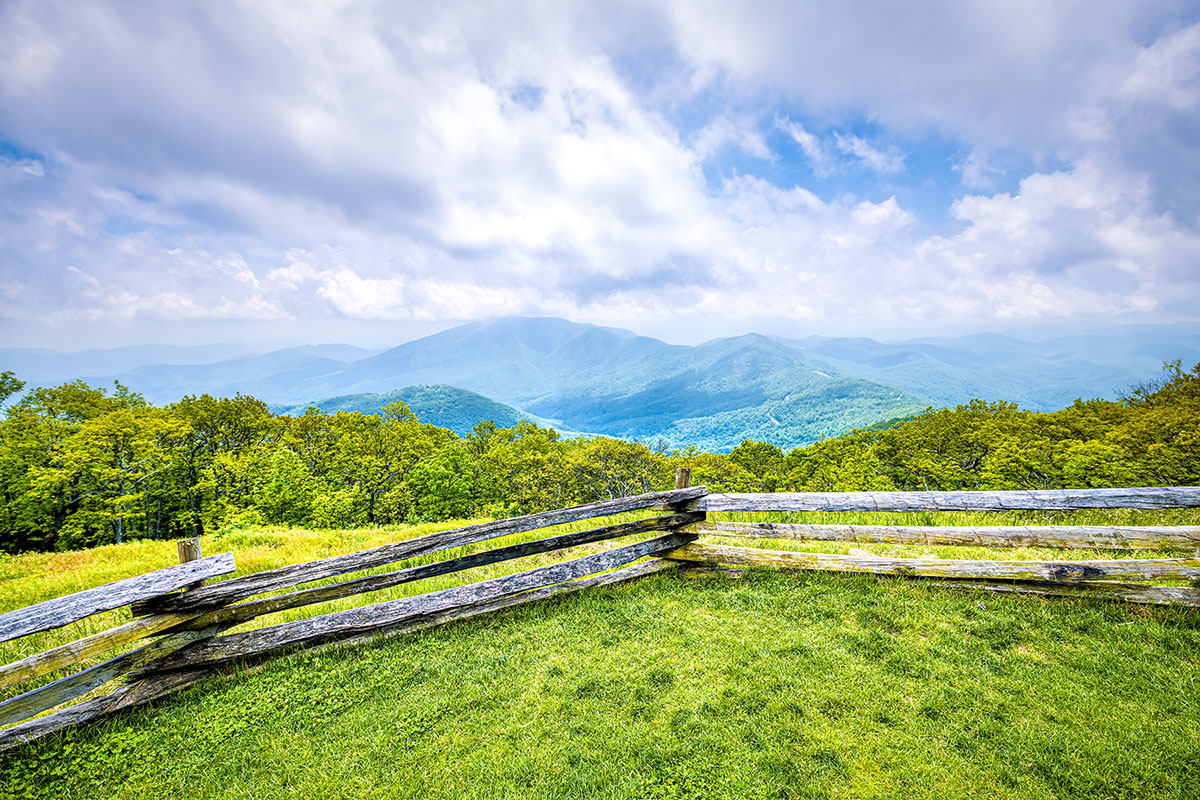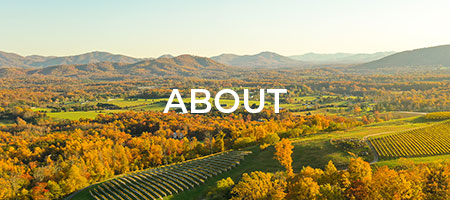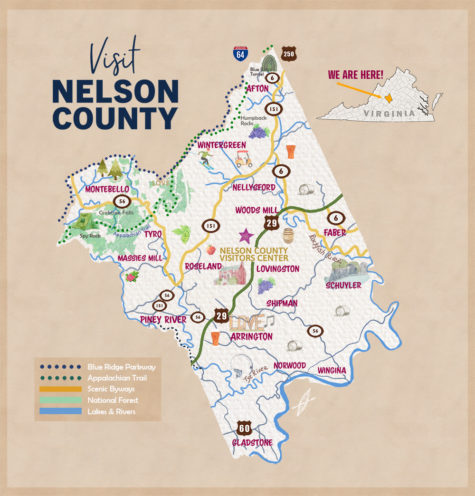Nelson County is a hidden gem in Central Virginia. Shaped like a diamond, there are surprises in every part of the 471 square mile playground of outdoor adventure.
Nelson’s northern border is the first 30 miles of the Virginia Blue Ridge Parkway; its southern border is the mighty James River, with all points between showcasing the county’s mountainous terrain that offers vistas of the Blue Ridge Mountains along with the deep green splendor of the George Washington National Forest.
Within this bounty of natural beauty are miles of hiking trails, crystal-clear fishing streams, historic family farms and orchards, picturesque vineyards, inviting tap rooms and unparalleled views.
Montebello & Crabtree Falls
Montebello, located just a few miles from milepost 27 on the Blue Ridge Parkway, is a place you can truly unplug and enjoy the natural beauty of an unspoiled village setting. Montebello is home to Crabtree Falls, the highest cascading waterfall east of the Mississippi River. Enjoy fishing and water activities along the Tye River. Many of the County’s orchards and farms are located near Montebello, so the entire family can find something to enjoy together in nature.
Piney River & The Blue Ridge Railway Trail
Nearby Montebello, the Piney River is known for freshwater fishing and outdoor adventure. The Virginia Blue Ridge Railway Trail is a 7 mile, easy, picturesque walk or cycle through a beautiful, natural setting with plentiful opportunities to see unique historical sites. The Piney and Tye Rivers are constant companions, and you’ll cross five bridges on the seven-mile route, including a photo-worthy covered bridge at Naked Creek.
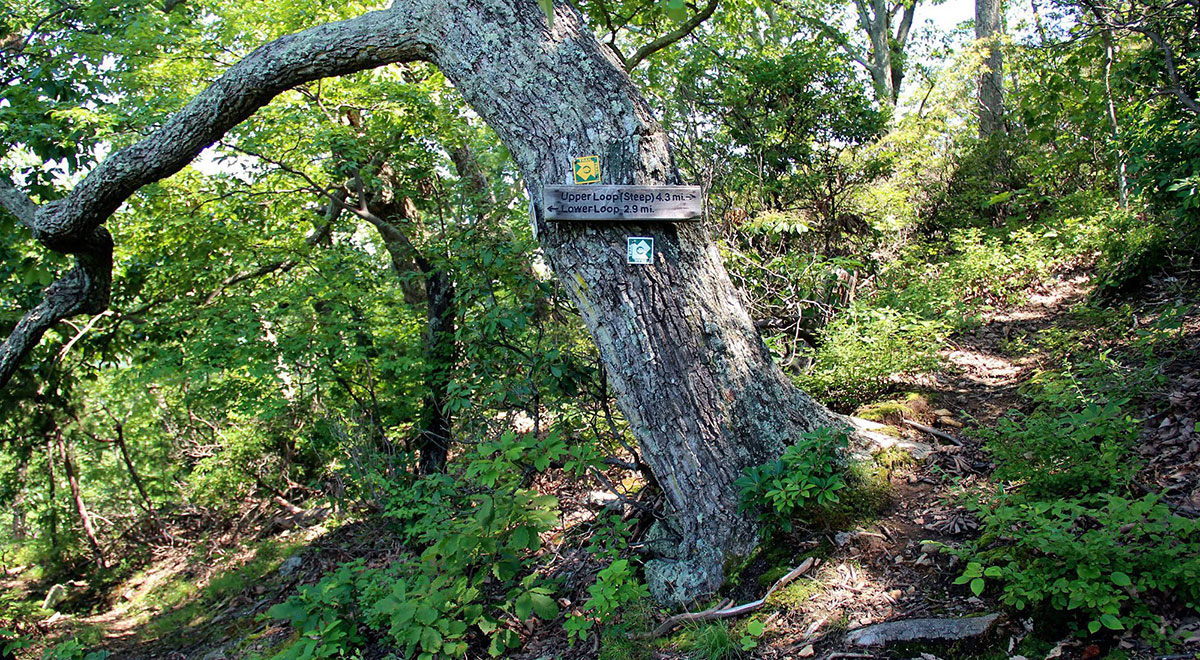
Lovingston
Travelling east to Route 29, Lovingston is the County seat. It is a quaint, walkable historic district with locally owned retail. lodging and food establishments. It is the perfect hub for a tour of the craft beverage producers along the Nelson 29 trail, with four wineries, two breweries and the producer of the first single malt whisky in America. Nearby Lovingston is the Rockfish River, a favorite place for kayaking, fishing and watchable wildlife. A little known hiking trail is Fortune’s Cove Preserve, a five-mile mountainous hike with seven viewpoints and a stream. It is owned and maintained by the Nature Conservancy. Several orchards and farms offer pick-your-own and farm markets for fresh, local products.
Schuyler
Schuyler is best known as the birthplace of Earl Hamner, Jr., creator of the television show, “The Waltons,” and is home to the Waltons Mountain Museum and a recently opened bed and breakfast at Earl Hamner’s former home place. Schuyler is also the headquarters for Alberene Soapstone, once the largest employer in the Commonwealth (where John Boy’s father worked), and boasts the world’s largest deposit of architectural soapstone in the world. The historic district is dotted with renovated Sears kit homes and the James River is just minutes away for more outdoor adventure.
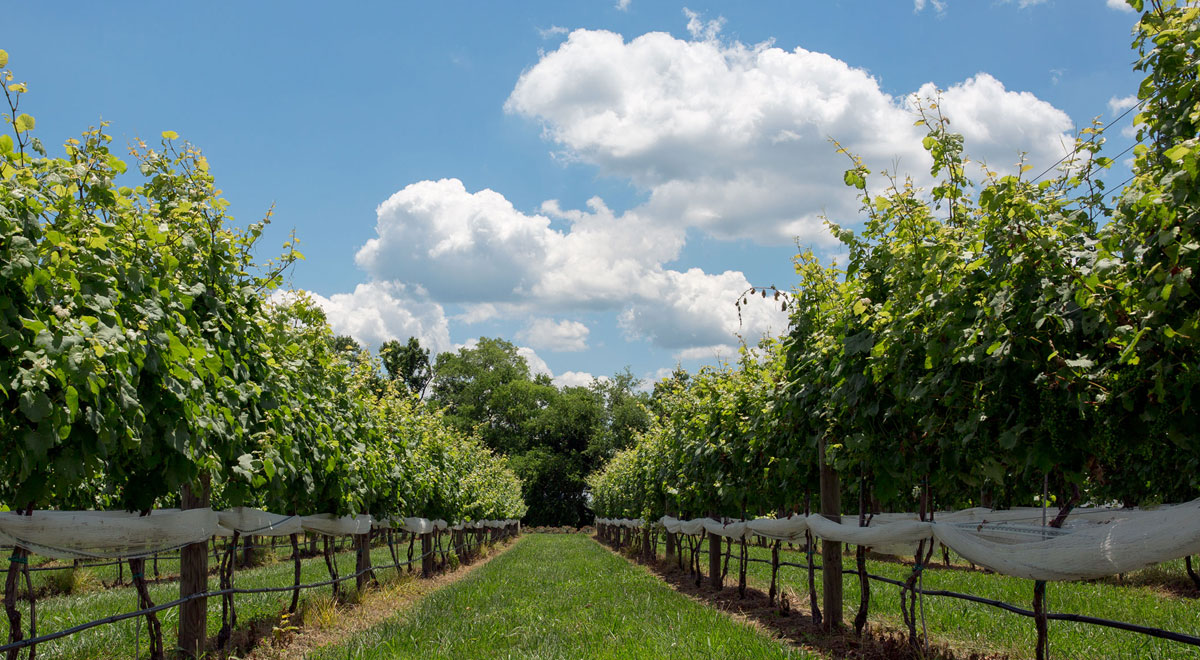
Nellysford & Wintergreen
In the center of Nelson County is the village of Nellysford, an affiliate Virginia Main Street community. It is another convenient hub for day trips along the Nelson 151 craft beverage trail, or a stay at Wintergreen Resort. Nelson 151 offers the craft beverage lover spectacular views and award winning beverages at fifteen locations along the twenty-mile stretch of one of Virginia’s scenic byways. Nelson 151 is Virginia’s Long Weekend Address, with five wineries, a meadery, four breweries, three cideries and two distilleries.
For the outdoor recreation enthusiast, there is the Rockfish Valley Loop Trail, which follows the South Rockfish River. Golfers can enjoy the course at Stoney Creek, the valley course owned by Wintergreen Resort. There is ample shopping along the corridor, as well as locally owned restaurants and lodging opportunities.
Afton
At the northern most corner of the County is the village of Afton. Home to several wineries and breweries on the Nelson 151 craft beverage trail, it is also home to the Blue Ridge Tunnel. Traveling through the long, dark tunnel is a stirring experience for a variety of visitors from across the Commonwealth and beyond: this shared-use trail is for hikers and cyclists of every level, wildlife watchers, history enthusiasts, railroad buffs, heritage tourists, school children on field trips, and nearby residents. Interpretive signs spread along the trail relay the history of the tunnel from the visionary engineer behind it (Claudius Crozet), to the Irish immigrants and slaves who labored through illness and lived in shanties.
History
Nelson County was formed in 1807 from Amherst County, and named in honor of Thomas Nelson, Jr., third governor of Virginia. Lovingston is the county seat. Originally the home of the Monocan tribe of Native Americans, a settlement along the James River was established by English colonists in the early 1700s. Another stream of settlers, of Scotch-Irish and German descent, came into the western sections of the county from the Shenandoah Valley. By the end of the 1800s, Nelson’s agricultural products included tobacco, apples and chestnut trees; the produce and lumber were carried to market by canal and railroad.
During the 1930s Earl Hamner, Jr. began writing of his experiences growing up in Nelson County during the Depression. Those writings eventually provided the substance for the The Waltons TV series. In 1969, Hurricane Camille caused a flood, devastating Nelson County. Since Camille, Nelson County has slowly recovered its land, its infrastructure and the will to grow and prosper again. Events that have aided in this recovery include: the 1972 development of Wintergreen Resort, the restoration in progress at Oak Ridge Estate, development of Walton’s Mountain Museum, the resurgence of the apple industry, the maturation of new vineyards, and the steady growth in Nelson County’s tourism industry.
GEOLOGIC HISTORY
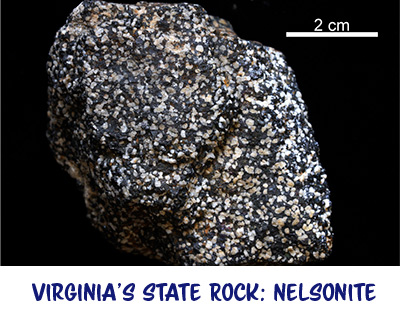 Visit the Nelson Memorial Library for a tour of the rocks that showcase the geologic history of the Blue Ridge.
Visit the Nelson Memorial Library for a tour of the rocks that showcase the geologic history of the Blue Ridge.
The rocks that underlie Nelson County contain clues to a long and complex geologic history. When we study these rocks, we are uncovering the geologic history of the Blue Ridge and western Piedmont, as we know them today. Blue Ridge geologic history is characterized by multiple cycles of tectonic plate collisions, rifting or pulling apart, then drifting. This cycle has repeated itself at least twice in the last one billion years.
About one billion years ago as the supercontinent Rodinia was formed, crustal plates collided and formed great mountains (the Grenville Mountains) where the Blue Ridge would eventually stand. These mountains were the ancestors of our present Blue Ridge. With the heat and pressures caused by burial beneath huge mountains, molten masses of rock formed and began to rise upward through the earth’s crust. Some of this molten material may have risen all the way to the surface and poured out as volcanic lava. But much of it crystallized deep beneath the surface, forming large blobs or plutons of granite. These granites are exposed at the surface today in central and western Nelson County, from Lovingston to Three Ridges Mountain.
